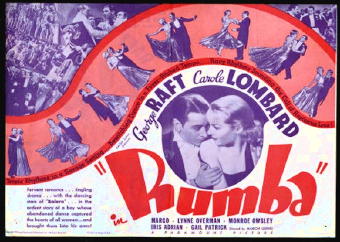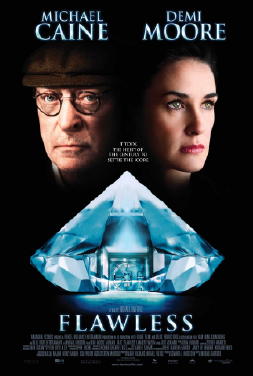May 2010
Monthly Archive
Thu 27 May 2010
Posted by Steve under
Reviews[7] Comments
REVIEWED BY DAN STUMPF:
ERROL FLYNN —
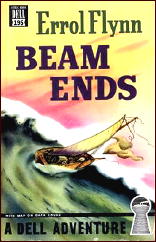
â—
Beam Ends. Longmans Green & Co., US, hardcover, 1937. Paperback reprint: Dell #195, 1947.
â—
Showdown. Sheridan House, US, hardcover, 1946. Paperback reprints include: Dell # 351, 1949; Pocket Cardinal, 1960.
It’s been a pretty mixed bag of reading/watching recently, starting with two books by Errol Flynn, Beam Ends (1937) and Showdown (1946) both quite well done and easily enjoyable.
Beam Ends tells the autobiographical tale of a voyage up the coast of Australia from Doney to New Guinea in a ship manifestly unsuited to the task. Flynn was in his early 20s when he launched this bit of adolescent insanity, and in his early 30s when he wrote of it — older but hardly wiser, and the book is suffused with that youthful energy that only comes once in life; somehow we never really appreciate being young and foolish till we get to be old and stupid.
Flynn’s prose is like his acting: hardly deep and not really skillful, but gracefully done and easy on the eyes.
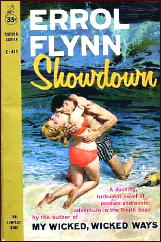
Pity, then, that it took him almost ten years to put out his only other book-length effort (I’m not counting the ghost-written posthumous autobiography My Wicked, Wicked Ways) a slight novel called Showdown.
But a fun one. Cast almost entirely with stock characters, Showdown tells of a footloose Irish sailor and his run-ins with missionaries, head-hunters, spies and movie stars in the South Seas.
A wild tale, acted out by a cast of characters no deeper than the thickness of pulp-paper, but fast-moving, suspenseful and quite readable. Turning the last page, I again got the feeling one gets from Errol Flynn’s movies: there’s talent here that’s fun to watch, but with a little more work it could have been something really fine.
Wed 26 May 2010
THE BACKWARD REVIEWER
William F. Deeck
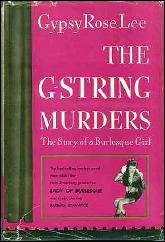
GYPSY ROSE LEE – The G-String Murder. Hardcover edition: Simon & Schuster, 1941. Also published as: Lady of Burlesque, Tower, hardcover, 1942. Ppaperback reprints include: Pocket #425, 1947; Pop. Library Eagle A3635, 1954; Avon T258, 1958. Penguin, 1984; The Feminist Press at CUNY, 2005. Possibly ghost-written by Craig Rice. Film: United Artists, 1943, as Lady of Burlesque, with Barbara Stanwyck as Dixie Daisy & Michael O’Shea as Biff Brannigan.
Burlesque impresario H. I. Moss brings Gypsy Rose Lee to the Old Opera Theater — “GIRLS! GIRLS! GIRLS! Laffs! Laffs! Laffs! Boxing Thursday Nights” — and Lee brings her old friend and fellow stripper Gee Gee Graham with her. Soon after their arrival, one of the strippers is strangled with her own G-string, and later another stripper is strangled with yet another G-string.
Biff Brannigan, the first comic and Lee’s boyfriend, is the unofficial detective in the novel. With his help the police unmask at least one murderer — or maybe a would-like-to-have-been murderer — meanwhile putting Lee’s life at risk.
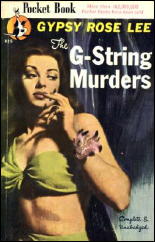
Most of the novel deals with the rather unpleasant backstage life of the performers, who aren’t a very mixed crew. Except for the one with a lisp, the strippers are hard to tell apart; they all sound alike in their dialogue, which is mostly puerile and self-centered.
They aren’t even, if we can believe the rather cattish comments of their peers, attractive physically. Also, more should have been done with what occurred on the stage, certainly the most interesting aspect of burlesque from the customers’ viewpoint.
Of interest, I would say, only to readers who enjoy show-business-type mysteries, who must be abundant or else there are still many doddering Lee-as-stripper fans around. As evidence, the recent Penguin Books reprint went into a second printing. The earlier Simon and Schuster edition went into printings of double figures, but Lee was still stripping strongly at the time and was in the movies.
(It appears to be accepted in mystery circles that Craig Rice wrote The G-String Murders. J.R. Christopher’s article in The MYSTERY FANcier 8:3, “Who Really Wrote the G-String Murders?” raises a question about this acceptance.
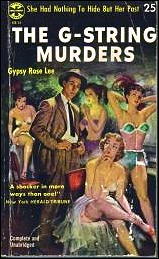
In a postscript to the Simon and Schuster edition, Lee is given full credit for the novel. It is said that she did all three drafts by herself, although for the final draft she had the aid of a thesaurus.
In Erik Lee Preminger’s Gypsy & Me, he mentions The G-String Murders several times, with no indication that anyone other than his mother wrote the book. Responding to a letter I wrote him, he said:
“The question of Craig Rice’s contribution to The G-String Murders was settled shortly after the book was published. Success has many fathers… Mother’s friend George Davis also claimed credit for G-String.
“I wasn’t around when Mother wrote the book. Georgia Sothern swore Mother wrote every word, as did Mother. And I saw her write every word of Gypsy.”
I don’t know what Mr. Preminger meant by Rice’s contribution having been settled, but he is obviously convinced that his mother did indeed write The G-String Murders. My conclusion, for what it’s worth, is that the novel does not have the Rice flair and reads as if Lee were the author — that is, that it is an amateurish effort.)
– From The MYSTERY FANcier, Vol. 10, No. 2, Spring 1988.
Editorial Comment: My own review of this book immediately precedes this one; or in other words, right here.
Wed 26 May 2010
Posted by Steve under
Reviews[7] Comments
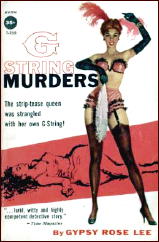
GYPSY ROSE LEE – The G-String Murder. Avon T258, reprint paperback, 1958. Hardcover edition: Simon & Schuster, 1941. Also published as: Lady of Burlesque, Tower, hardcover, 1942. Other paperback reprints include: Pocket #425, 1947; Pop. Library Eagle A3635, 1954; Penguin, 1984; The Feminist Press at CUNY, 2005. Possibly ghost-written by Craig Rice. Film: United Artists, 1943, as Lady of Burlesque, with Barbara Stanwyck as Dixie Daisy.
The famous stripper helps solve two “impossible” crimes occurring in the rundown burlesque theater where she’s appearing. While extremely mild today, for 1941 this book must have been something else, bawdier and racier than almost anything — except for Thorne Smith’s “Topper” books, of course. The detective work which fills the second half is awfully weak, though — both confused and confusing.
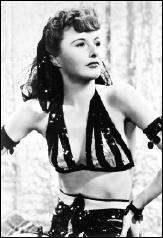
COMMENT: I’ve re-read the final couple of chapters a couple of times now, and I’ve finally decided it’s just not worth the effort.
I’m not alone, either. Because of the locked room aspects, the book is included in Bob Adey’s book on the same, but when it comes to an explanation, here’s what he says: “The solution could be a second door, an open window, or simply the removal and replacement of the original seal — take your pick.”
I didn’t read any of this in the book I read. [WARNING] What I thought happened was that the body was put into the room before the wax seal was put on the lock. The second murder, with the body found inside a locked prop room, has an even simpler solution. The killer had a key. (Bob Adey doesn’t even mention this one.)
— Reprinted from Mystery*File #35, November 1993.
[UPDATE] 05-26-10. The comment above was published at the same time (and place) as the review. I didn’t go into the provenance of the book then, but Bill Deeck did when he also reviewed the book, a review that will be posted next.
Wed 26 May 2010
REVIEWED BY WALTER ALBERT:
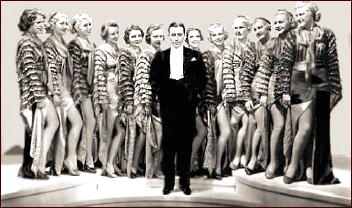
RUMBA. Paramount, 1935. George Raft, Carole Lombard, Lynne Overmann, Margo, Iris Adrian, Gail Patrick.
Photography: Ted Teztlaff; art direction: Hans Dreier and Robert Usher. Dances and ensembles staged by LeRoy Prinz; specialty dance created and staged by Veloz and Yolanda. Director: Marion Gering. Shown at Cinecon 45, Hollywood CA, September 2009.
Maybe I was just worn down by four days of movie watching, but this second pairing of Raft and Lombard (after their success in Bolero, 1934) didn’t consistently hold my interest.
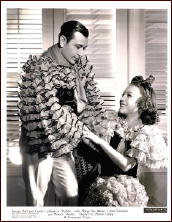
Lombard is a socialite, Raft a dancer, both of them with the same winning lottery ticket, but Raft’s is shown to be a counterfeit and he is forced to return the money. When Lombard sees him dance and recognizes his talent, she tries to give him back the money but he refuses to take it.
The film continues along this path of characters at odds, from different social classes and different temperaments, the. reserved Lombard, the hot-tempered Raft, but fated to be drawn to each other. The complex mix is eventually resolved by a dance that climaxes the film and cements their relationship.
The film’s strong suits are a pulsating, insidiously seductive Latin beat, and a striking performance by Margo as the Latino dancer who is Lombard’s rival for Raft as a dance partner and as a lover. (Seen with George Raft in the photo above and to the left.)
Wed 26 May 2010
Posted by Steve under
Reviews[28] Comments
On her blog, author Jane Haddam takes issue with my review of her book Cheating at Solitaire here on this one. She’s certainly right to take issue. Overall I didn’t find the book particularly rewarding, and I tried to explain why.
I did end the review on a positive note by suggesting that “…values are the key to Cheating at Solitaire — hometown values, small town values, I don’t believe it matters either way. Maybe they’re even universal values and and maybe this is why readers keep coming back for more.”
Earlier on, though, I expressed my displeasure with the lack of actual detection that went on in what I assumed to be a book about a detective, ex-FBI agent Gregor Demarkian, the leading character in most if not all of the author’s books. I had to conclude that solving a mystery, the undoing of a puzzle plot, was not one of the reasons readers keep coming back for more of his adventures.
Nor does Jane Haddam deny it. Quoting here and there from her comments, and you can go read them in full to fill in any blanks I’ve omitted, she says:
“Now, I’ve got a sneaking suspicion that the author of the review/blog linked above is male. In my experience, men tend to like lots of plot and to see nothing but wasted time and space in a concentration on character.
“But even so, even most plot-besotted readers should have noticed by now that there really isn’t anything new in the way of plot out there, and hasn’t been for years. There isn’t much new in the way of detection, either. I’ve been watching my way through four and a half seasons of the old Perry Mason, and I can see the plots coming down the pike as predictably as summer follows spring.
[…]
“I guess what I’m saying here is that I can’t imagine reading a mystery for the plot, and I really have no particular use for reading one for the continuing characters, who are either going to be boring as hell in no time at all or are going to have the kind of overwrought lives that make Dark Shadows look like a children’s story.
“Apparently, however, a lot of people out there are innocent of the idea that you might want to read mystery fiction for any other reason.”
So there we are, miles apart. Miles. (But you might also want to read my second paragraph above again.)
Tue 25 May 2010
Posted by Steve under
General[4] Comments
Copied from the TCM website, the following news:
TCM Ready to Shine Brightly with Eighth Edition of SUMMER UNDER THE STARS —
The dog days of summer are the best time of the year for movie fans as they turn on the air conditioning and park themselves on the couch for the latest edition of Turner Classic Movies’ (TCM) ultimate movie star showcase: SUMMER UNDER THE STARS. Now in its eighth year, the August festival dedicates each of its 31 days to one of Hollywood’s most enduring actors and actresses. Assembled from the network’s library of more than 5,000 films, this one-of-a-kind festival is an opportunity for viewers to enjoy a varied selection from each star’s body of work, uncut and commercial free.
Fourteen of the month’s actors and actresses featured in this year’s SUMMER UNDER THE STARS are first-timers to the festival. The memorable performers include five Oscar® winners: Julie Christie (Aug. 2), Ethel Barrymore (Aug. 4), Margaret O’Brien (Aug. 8), Warren Beatty (Aug. 9) and John Mills (Aug. 22). Other stars getting their first showcases include Woody Strode (Aug. 5), Kathryn Grayson (Aug. 10), Gene Tierney (Aug. 14), Robert Stack (Aug. 17), Ann Sheridan (Aug. 18), Walter Pidgeon (Aug. 19), John Gilbert (Aug. 24), Lee Remick (Aug. 26) and Thelma Todd (Aug. 30).
This year’s SUMMER UNDER THE STARS also features 52 films making their first appearances on TCM during the festival, including I Was Monty’s Double (1958), starring John Mills and M.E. Clifton-James, who really was General Montgomery’s double during World War II; Richard Lester’s decade-defining film Petulia (1968), with Julie Christie and George C. Scott; the film adaptation of Joe Orton’s frantic play Loot (1970) and the concert-piano drama The Competition (1980), both starring Lee Remick; Richard Rush’s incisive black comedy The Stunt Man (1980), with Peter O’Toole in a brilliant performance; an extensive collection of early comedies featuring Thelma Todd; and the Hope-and-Crosby-style comedy Ishtar (1987), with Warren Beatty and Dustin Hoffman.
>>>
Thanks and a tip of the hat for this advance notice to Ivan G. Shreve, Jr., whose Thrilling Days of Yesteryear is one of the blogs I take a look at every day, and if you love old movies and old TV shows, as well as Old Time Radio, then you should too.
You can see the entire August schedule for yourself, but Ivan goes through each of the 31 days of the month and points out the highlights of each from his point of view. (Follow the link above.) Often his is the same as mine, but what he has to say depends on which of the movies he already has on tape or DVD, and which he doesn’t, and I have a feeling that his collection is bigger than mine. Either way, there’s a lot to be looking forward to!
Tue 25 May 2010
Posted by Steve under
Reviews[5] Comments
IT IS PURELY MY OPINION
Reviews by L. J. Roberts
J. D. ROBB (aka NORA ROBERTS) – Fantasy in Death. Putnam, hardcover, February 2010. Reprint paperback: Berkley, July 2010.
Genre: Police procedural. Leading character: Det. Eve Dallas, 37th in series. Setting: New York City–Future/2060.
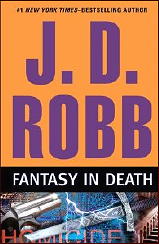
First Sentence: While swords of lightning slashed and stabbed murderously across the scarred shield of sky, Bart Minnock whistled his way home for the last time.
U-Play is a fast-rising gaming company with a quartet of co-owners. One of them takes the disk home for a game in development, and literally loses his head over it. Lt. Eve Dallas is faced with a locked-room mystery where she and her team have to find out not only who did it, but how it was done.
Reading J. D. Robb has always been one of my guilty pleasures. I enjoy her voice and her humor. Only Robb can write a conversation about private parts that is neither silly, salacious or scatological, but is laugh-out-loud funny.
She has such a wonderful ear for dialogue and banter. I appreciate her references to books, literature, television and movies, including a delightful homage to “The Godfather.”
She also does a very good creating life in 2060; the not-too-distant future. It’s a tricky balance of making it seem possible but not fantastical. “It’s always fiction until science catches up.”
The focus of this book is relationships; friends, partners, lovers. It is nice watching Eve develop emotionally with each book and the sexual relationship with Roark, while still there, be less prominent. The usual supporting relationships were all there in a more cameo role than in the past, but they contributed to the theme.
Where the book fell apart a bit, for me, was the plot. It started off really well as a locked-room mystery. There were viable suspects and some good red herrings. However, because of the type of crime, it didn’t quite make sense that Eve was the one who came up with the solution; the logic, perhaps, but not the technicality.
The final climatic scene seemed abrupt and over the top. I did enjoy the book, do still enjoy the series and know I’ll continue reading it, but would like to see Robb/Roberts change it up a bit.
Rating: Good.
Editorial Comment: Can there already really be 37 in this series? The first one was Naked in Death, which came out in 1995 as a paperback original from Berkley. That’s well over two books a year ever since.
But when I went to look the series up online, I found that while the Fantastic Fiction website agrees that Fantasy in Death is #37 in the series, it appears that a few of the 37 were only long novelettes that appeared in collections with other authors. Looking further on the same page, though, I see that some of these have been published individually as novellas under the J. D. Robb byline, so I’m assuming the number is at least semi-legitimate and to let it stand.
Tue 25 May 2010
A REVIEW BY CURT J. EVANS:
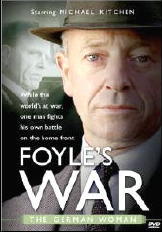
FOYLE’S WAR. ITV (UK), PBS (US). Episode One: The German Woman. 27 October 2002 (UK date). Michael Kitchen (Det. Supt. Christopher Foyle), Honeysuckle Weeks (Samantha Stewart), Anthony Howell (Sgt. Paul Milner), Edward Fox, Robert Hardy, David Horovitch, Joanna Kanska, Dominic Mafham, Julian Ovenden, Rosamund Pike, Elizabeth Bell, James McAvoy. Series creator: Anthony Horowitz.
Eight years after it aired, I finally watched the first episode of the Foyle’s Way series, “The German Woman.” I see what the fuss has been about now.
Beautifully filmed, splendidly cast and intelligently written, this debut episode in the series has a lot about it to like. As the Detective Superintendent, Michael Kitchen has amazing gravitas and droll charm. His character is Always Right on the weighty moral issues this and other episodes of the series address, and you just wish he were in charge of the whole darn, messed-up world.
Kitchen seems too splendid an actor for one not to have seen him before — I do remember him from Enchanted April but not from Out of Africa (of course this film is from 25 years ago!) and I can’t recall seeing him anything else. Any road, he’ll be remembered in posterity for this series, I have no doubt, just like David Suchet will be for Poirot.
As his spunky driver “Sam,” Honeysuckle Weeks is an amazingly appealing presence who gives the series an acceptable bit of Girl Power! She looks so young here too, in this episode from eight years ago.
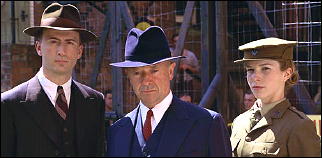
Foyle’s son, Andrew, is played by Julian Ovenden, who had a role in the Poirot film After the Funeral. He makes less of an impression here, but I understand that the character developed more over the course of the series (he did not appear in the latest season).
Anthony Howell, the very serious son from Wives and Daughters, the 1999 film of the Elizabeth Gaskell novel, plays the very serious Sergeant Paul Milner, the wounded war hero (he lost part of a leg) who goes to work for Foyle in the police force. He’s always a strong and substantial presence.
The supporting cast is an embarrassment of riches, with David Horovitch (Inspector Slack from the Joan Hickson “Marple” series and Isaac from Ivanhoe) as a victimized German internee, Robert Hardy as a foolish aristocrat (he played this role before — very well — in Middlemarch), Rosmaund Pike (seen most recently in the Oscar-nominated film An Education) as his snide and bratty daughter and James McAvoy — now a major film star — in the small but memorably played role of the lovelorn druggist’s assistant.
This excellent cast stars in a film that addresses the morality of Britain’s alien internment policy during World War Two. Just as the United States instituted an unjust internment policy in regard to the Japanese residents in the country, so did Britain in regard to Germans and Italians. In some cases, even German Jewish refuges were rounded up — a rather obviously nonsensical policy.
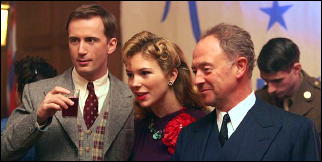
The unjustness of all this is touched on by “The German Woman,” and most happily, it’s done within the framework of a classical, Golden Age style British mystery. The German wife of a local bigwig aristocrat is herself left untouched and resentment against her stirs in the local community after a German bomb is dropped on a pub, killing a young woman.
When the German woman is killed in a particularly nasty way while out riding, it’s thought a local seeking revenge on Germans may be responsible, but other paths of suspicion appear as well, some leading within the confines her own family….
You might, as I did, suspect a certain party very quickly, but motive still provides an interesting question. The only quibble I would have is that the murderer, when confronted by Foyle, quite improbably confesses; but this is a script convenience I can pass over with so many other excellences. This is British mystery film making at its highest level.
Editorial Comment: Truth in Advertising. Although I do not remember it, it is possible that the first photo of the three stars together came from this first episode, but almost assuredly the second one did not.
Mon 24 May 2010
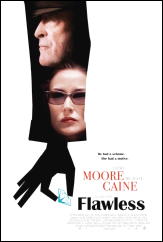
FLAWLESS. Magnolia Pictures, 2007. Demi Moore, Michael Caine, Lambert Wilson, Nathaniel Parker. Director: Michael Radford.
Any movie with this title ought to be good – better than good, in fact, maybe even perfect – but all I can tell you is that this movie is only better than good. It’s a story that takes place in England and inside the headquarters of the world’s largest diamond exchange.
It’s also the story of a female executive (Demi Moore) who keeps getting passed over for promotions when in fact it is her suggestions the firm is often acting upon, and a janitor (Michael Caine) who has not only a plan but a motive (his wife’s death) to steal a handful of diamonds – they’ll never miss them, he tells her. All he needs is the combination, he says, and she’s the only one who can get it for him.
Janitors, it turns out, are never noticed, even when they’re in the same room where confidences are being made, and they’re also privy to all kinds of information carelessly tossed into the trash. She’s being terminated, he tells her, or at least her job is. Sure enough, he’s right. And she’s in.
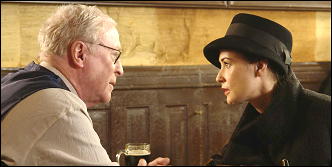
There is a twist that I didn’t see coming that comes along next, and telling you even that is more than I think I should, but every other review you read is going to tell you this or more, and by the time you read the next post on this blog, probably tomorrow, you’ll have forgotten anyway.
Any movie with Michael Caine in it is going to be good, if only for the scenes he’s in, and Demi Moore, looking noticeably older than she did in G. I. Jane, say (1997), is a much better actor than I think she’s given credit for.
She always has this innate sense of vulnerability about her performances, even those in which she’s as strong a character as she is in G. I. Jane, which makes all her roles all the more interesting, even in films that (I admit) are not all that strong to begin with.
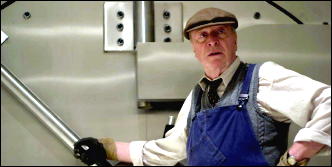
Getting back to Michael Caine, though, he’s definitely the man with a plan – he’s been waiting for his chance at revenge for a considerable length of time, so obviously he’s had plenty of time to work out the details. Only his strong British accent – Cockney? I’m no expert – can possibly flaw his performance here, and then in terms of American ears only.
I’m ambivalent about the framing device for this movie, but surprisingly enough – I hate prologues – it’s the ending which I found to be the weaker bookend, possibly a little too preachy to some minds?
Well, perhaps. Not enough to mar the show, though, which is turn moderately clever and suspenseful, and which I plan to watch again for all of the little things I’m sure I missed — or maybe even to nitpick the flaws a little more thoroughly. The first time, though, I mostly sat back and enjoyed the top-notch performances of this movie’s top two stars.
Mon 24 May 2010
Posted by Steve under
Reviews[4] Comments
REVIEWED BY WALTER ALBERT:
VICTORIA LAURIE – Doom with a View: A Psychic Eye Mystery. Obsidian, paperback original, September 2009.
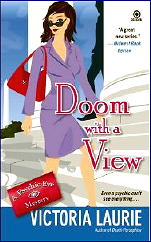
Psychic Abigail (“Abby”) Cooper and her pal PI Candice Fusco join an FBI team headed by sceptic Brice Harrison in an investigation of a search for some missing college students. Not unexpectedly, Harrison proves to be difficult to work with, even in the face of progress resulting from Abby’s psychic gifts.
Some surprising, and initially not entirely welcome, changes occur in Abby’s life as a result of this new direction in her career, but the light touch of this romantic mystery series continues to entertain the reader open to the unconventional techniques of the amateur sleuth.
Previously reviewed on this blog:
Two by Victoria Laurie: What’s a Ghoul Got to Do? and A Vision of Murder (by Walter Albert)
Crime Seen (by Steve Lewis)
« Previous Page — Next Page »









